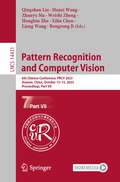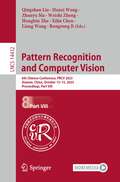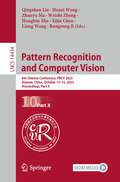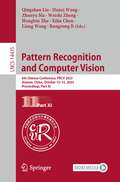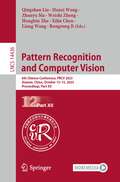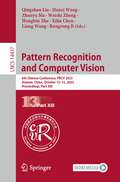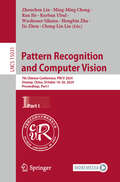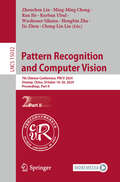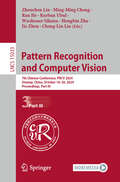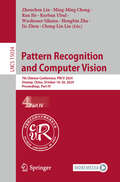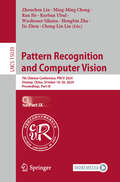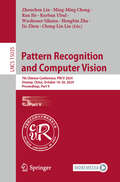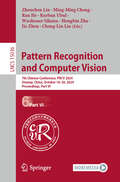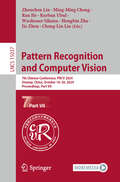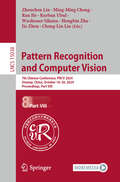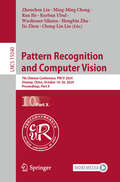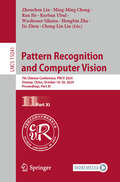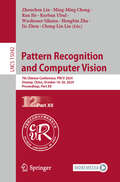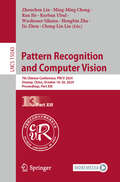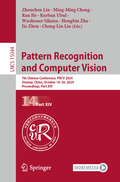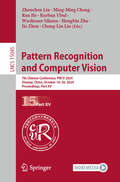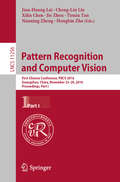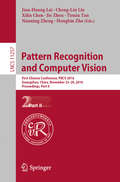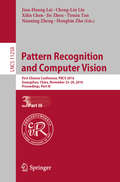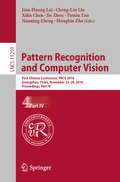- Table View
- List View
Pattern Recognition and Computer Vision: 6th Chinese Conference, PRCV 2023, Xiamen, China, October 13–15, 2023, Proceedings, Part VII (Lecture Notes in Computer Science #14431)
by Liang Wang Qingshan Liu Weishi Zheng Xilin Chen Hongbin Zha Rongrong Ji Hanzi Wang Zhanyu MaThe 13-volume set LNCS 14425-14437 constitutes the refereed proceedings of the 6th Chinese Conference on Pattern Recognition and Computer Vision, PRCV 2023, held in Xiamen, China, during October 13–15, 2023. The 532 full papers presented in these volumes were selected from 1420 submissions. The papers have been organized in the following topical sections: Action Recognition, Multi-Modal Information Processing, 3D Vision and Reconstruction, Character Recognition, Fundamental Theory of Computer Vision, Machine Learning, Vision Problems in Robotics, Autonomous Driving, Pattern Classification and Cluster Analysis, Performance Evaluation and Benchmarks, Remote Sensing Image Interpretation, Biometric Recognition, Face Recognition and Pose Recognition, Structural Pattern Recognition, Computational Photography, Sensing and Display Technology, Video Analysis and Understanding, Vision Applications and Systems, Document Analysis and Recognition, Feature Extraction and Feature Selection, Multimedia Analysis and Reasoning, Optimization and Learning methods, Neural Network and Deep Learning, Low-Level Vision and Image Processing, Object Detection, Tracking and Identification, Medical Image Processing and Analysis.
Pattern Recognition and Computer Vision: 6th Chinese Conference, PRCV 2023, Xiamen, China, October 13–15, 2023, Proceedings, Part VIII (Lecture Notes in Computer Science #14432)
by Liang Wang Qingshan Liu Weishi Zheng Xilin Chen Hongbin Zha Rongrong Ji Hanzi Wang Zhanyu MaThe 13-volume set LNCS 14425-14437 constitutes the refereed proceedings of the 6th Chinese Conference on Pattern Recognition and Computer Vision, PRCV 2023, held in Xiamen, China, during October 13–15, 2023. The 532 full papers presented in these volumes were selected from 1420 submissions. The papers have been organized in the following topical sections: Action Recognition, Multi-Modal Information Processing, 3D Vision and Reconstruction, Character Recognition, Fundamental Theory of Computer Vision, Machine Learning, Vision Problems in Robotics, Autonomous Driving, Pattern Classification and Cluster Analysis, Performance Evaluation and Benchmarks, Remote Sensing Image Interpretation, Biometric Recognition, Face Recognition and Pose Recognition, Structural Pattern Recognition, Computational Photography, Sensing and Display Technology, Video Analysis and Understanding, Vision Applications and Systems, Document Analysis and Recognition, Feature Extraction and Feature Selection, Multimedia Analysis and Reasoning, Optimization and Learning methods, Neural Network and Deep Learning, Low-Level Vision and Image Processing, Object Detection, Tracking and Identification, Medical Image Processing and Analysis.
Pattern Recognition and Computer Vision: 6th Chinese Conference, PRCV 2023, Xiamen, China, October 13–15, 2023, Proceedings, Part X (Lecture Notes in Computer Science #14434)
by Liang Wang Qingshan Liu Weishi Zheng Xilin Chen Hongbin Zha Rongrong Ji Hanzi Wang Zhanyu MaThe 13-volume set LNCS 14425-14437 constitutes the refereed proceedings of the 6th Chinese Conference on Pattern Recognition and Computer Vision, PRCV 2023, held in Xiamen, China, during October 13–15, 2023. The 532 full papers presented in these volumes were selected from 1420 submissions. The papers have been organized in the following topical sections: Action Recognition, Multi-Modal Information Processing, 3D Vision and Reconstruction, Character Recognition, Fundamental Theory of Computer Vision, Machine Learning, Vision Problems in Robotics, Autonomous Driving, Pattern Classification and Cluster Analysis, Performance Evaluation and Benchmarks, Remote Sensing Image Interpretation, Biometric Recognition, Face Recognition and Pose Recognition, Structural Pattern Recognition, Computational Photography, Sensing and Display Technology, Video Analysis and Understanding, Vision Applications and Systems, Document Analysis and Recognition, Feature Extraction and Feature Selection, Multimedia Analysis and Reasoning, Optimization and Learning methods, Neural Network and Deep Learning, Low-Level Vision and Image Processing, Object Detection, Tracking and Identification, Medical Image Processing and Analysis.
Pattern Recognition and Computer Vision: 6th Chinese Conference, PRCV 2023, Xiamen, China, October 13–15, 2023, Proceedings, Part XI (Lecture Notes in Computer Science #14435)
by Liang Wang Qingshan Liu Weishi Zheng Xilin Chen Hongbin Zha Rongrong Ji Hanzi Wang Zhanyu MaThe 13-volume set LNCS 14425-14437 constitutes the refereed proceedings of the 6th Chinese Conference on Pattern Recognition and Computer Vision, PRCV 2023, held in Xiamen, China, during October 13–15, 2023. The 532 full papers presented in these volumes were selected from 1420 submissions. The papers have been organized in the following topical sections: Action Recognition, Multi-Modal Information Processing, 3D Vision and Reconstruction, Character Recognition, Fundamental Theory of Computer Vision, Machine Learning, Vision Problems in Robotics, Autonomous Driving, Pattern Classification and Cluster Analysis, Performance Evaluation and Benchmarks, Remote Sensing Image Interpretation, Biometric Recognition, Face Recognition and Pose Recognition, Structural Pattern Recognition, Computational Photography, Sensing and Display Technology, Video Analysis and Understanding, Vision Applications and Systems, Document Analysis and Recognition, Feature Extraction and Feature Selection, Multimedia Analysis and Reasoning, Optimization and Learning methods, Neural Network and Deep Learning, Low-Level Vision and Image Processing, Object Detection, Tracking and Identification, Medical Image Processing and Analysis.
Pattern Recognition and Computer Vision: 6th Chinese Conference, PRCV 2023, Xiamen, China, October 13–15, 2023, Proceedings, Part XII (Lecture Notes in Computer Science #14436)
by Liang Wang Qingshan Liu Weishi Zheng Xilin Chen Hongbin Zha Rongrong Ji Hanzi Wang Zhanyu MaThe 13-volume set LNCS 14425-14437 constitutes the refereed proceedings of the 6th Chinese Conference on Pattern Recognition and Computer Vision, PRCV 2023, held in Xiamen, China, during October 13–15, 2023. The 532 full papers presented in these volumes were selected from 1420 submissions. The papers have been organized in the following topical sections: Action Recognition, Multi-Modal Information Processing, 3D Vision and Reconstruction, Character Recognition, Fundamental Theory of Computer Vision, Machine Learning, Vision Problems in Robotics, Autonomous Driving, Pattern Classification and Cluster Analysis, Performance Evaluation and Benchmarks, Remote Sensing Image Interpretation, Biometric Recognition, Face Recognition and Pose Recognition, Structural Pattern Recognition, Computational Photography, Sensing and Display Technology, Video Analysis and Understanding, Vision Applications and Systems, Document Analysis and Recognition, Feature Extraction and Feature Selection, Multimedia Analysis and Reasoning, Optimization and Learning methods, Neural Network and Deep Learning, Low-Level Vision and Image Processing, Object Detection, Tracking and Identification, Medical Image Processing and Analysis.
Pattern Recognition and Computer Vision: 6th Chinese Conference, PRCV 2023, Xiamen, China, October 13–15, 2023, Proceedings, Part XIII (Lecture Notes in Computer Science #14437)
by Liang Wang Qingshan Liu Weishi Zheng Xilin Chen Hongbin Zha Rongrong Ji Hanzi Wang Zhanyu MaThe 13-volume set LNCS 14425-14437 constitutes the refereed proceedings of the 6th Chinese Conference on Pattern Recognition and Computer Vision, PRCV 2023, held in Xiamen, China, during October 13–15, 2023. The 532 full papers presented in these volumes were selected from 1420 submissions. The papers have been organized in the following topical sections: Action Recognition, Multi-Modal Information Processing, 3D Vision and Reconstruction, Character Recognition, Fundamental Theory of Computer Vision, Machine Learning, Vision Problems in Robotics, Autonomous Driving, Pattern Classification and Cluster Analysis, Performance Evaluation and Benchmarks, Remote Sensing Image Interpretation, Biometric Recognition, Face Recognition and Pose Recognition, Structural Pattern Recognition, Computational Photography, Sensing and Display Technology, Video Analysis and Understanding, Vision Applications and Systems, Document Analysis and Recognition, Feature Extraction and Feature Selection, Multimedia Analysis and Reasoning, Optimization and Learning methods, Neural Network and Deep Learning, Low-Level Vision and Image Processing, Object Detection, Tracking and Identification, Medical Image Processing and Analysis.
Pattern Recognition and Computer Vision: 7th Chinese Conference, PRCV 2024, Urumqi, China, October 18–20, 2024, Proceedings, Part I (Lecture Notes in Computer Science #15031)
by Ran He Jie Zhou Cheng-Lin Liu Ming-Ming Cheng Kurban Ubul Hongbin Zha Zhouchen Lin Wushouer SilamuThis 15-volume set LNCS 15031-15045 constitutes the refereed proceedings of the 7th Chinese Conference on Pattern Recognition and Computer Vision, PRCV 2024, held in Urumqi, China, during October 18–20, 2024. The 579 full papers presented were carefully reviewed and selected from 1526 submissions. The papers cover various topics in the broad areas of pattern recognition and computer vision, including machine learning, pattern classification and cluster analysis, neural network and deep learning, low-level vision and image processing, object detection and recognition, 3D vision and reconstruction, action recognition, video analysis and understanding, document analysis and recognition, biometrics, medical image analysis, and various applications.
Pattern Recognition and Computer Vision: 7th Chinese Conference, PRCV 2024, Urumqi, China, October 18–20, 2024, Proceedings, Part II (Lecture Notes in Computer Science #15032)
by Ran He Jie Zhou Cheng-Lin Liu Ming-Ming Cheng Kurban Ubul Hongbin Zha Zhouchen Lin Wushouer SilamuThis 15-volume set LNCS 15031-15045 constitutes the refereed proceedings of the 7th Chinese Conference on Pattern Recognition and Computer Vision, PRCV 2024, held in Urumqi, China, during October 18–20, 2024. The 579 full papers presented were carefully reviewed and selected from 1526 submissions. The papers cover various topics in the broad areas of pattern recognition and computer vision, including machine learning, pattern classification and cluster analysis, neural network and deep learning, low-level vision and image processing, object detection and recognition, 3D vision and reconstruction, action recognition, video analysis and understanding, document analysis and recognition, biometrics, medical image analysis, and various applications.
Pattern Recognition and Computer Vision: 7th Chinese Conference, PRCV 2024, Urumqi, China, October 18–20, 2024, Proceedings, Part III (Lecture Notes in Computer Science #15033)
by Ran He Jie Zhou Cheng-Lin Liu Ming-Ming Cheng Kurban Ubul Hongbin Zha Zhouchen Lin Wushouer SilamuThis 15-volume set LNCS 15031-15045 constitutes the refereed proceedings of the 7th Chinese Conference on Pattern Recognition and Computer Vision, PRCV 2024, held in Urumqi, China, during October 18–20, 2024. The 579 full papers presented were carefully reviewed and selected from 1526 submissions. The papers cover various topics in the broad areas of pattern recognition and computer vision, including machine learning, pattern classification and cluster analysis, neural network and deep learning, low-level vision and image processing, object detection and recognition, 3D vision and reconstruction, action recognition, video analysis and understanding, document analysis and recognition, biometrics, medical image analysis, and various applications.
Pattern Recognition and Computer Vision: 7th Chinese Conference, PRCV 2024, Urumqi, China, October 18–20, 2024, Proceedings, Part IV (Lecture Notes in Computer Science #15034)
by Ran He Jie Zhou Cheng-Lin Liu Ming-Ming Cheng Kurban Ubul Hongbin Zha Zhouchen Lin Wushouer SilamuThis 15-volume set LNCS 15031-15045 constitutes the refereed proceedings of the 7th Chinese Conference on Pattern Recognition and Computer Vision, PRCV 2024, held in Urumqi, China, during October 18–20, 2024. The 579 full papers presented were carefully reviewed and selected from 1526 submissions. The papers cover various topics in the broad areas of pattern recognition and computer vision, including machine learning, pattern classification and cluster analysis, neural network and deep learning, low-level vision and image processing, object detection and recognition, 3D vision and reconstruction, action recognition, video analysis and understanding, document analysis and recognition, biometrics, medical image analysis, and various applications.
Pattern Recognition and Computer Vision: 7th Chinese Conference, PRCV 2024, Urumqi, China, October 18–20, 2024, Proceedings, Part IX (Lecture Notes in Computer Science #15039)
by Ran He Jie Zhou Cheng-Lin Liu Ming-Ming Cheng Kurban Ubul Hongbin Zha Zhouchen Lin Wushouer SilamuThis 15-volume set LNCS 15031-15045 constitutes the refereed proceedings of the 7th Chinese Conference on Pattern Recognition and Computer Vision, PRCV 2024, held in Urumqi, China, during October 18–20, 2024. The 579 full papers presented were carefully reviewed and selected from 1526 submissions. The papers cover various topics in the broad areas of pattern recognition and computer vision, including machine learning, pattern classification and cluster analysis, neural network and deep learning, low-level vision and image processing, object detection and recognition, 3D vision and reconstruction, action recognition, video analysis and understanding, document analysis and recognition, biometrics, medical image analysis, and various applications.
Pattern Recognition and Computer Vision: 7th Chinese Conference, PRCV 2024, Urumqi, China, October 18–20, 2024, Proceedings, Part V (Lecture Notes in Computer Science #15035)
by Ran He Jie Zhou Cheng-Lin Liu Ming-Ming Cheng Kurban Ubul Hongbin Zha Zhouchen Lin Wushouer SilamuThis 15-volume set LNCS 15031-15045 constitutes the refereed proceedings of the 7th Chinese Conference on Pattern Recognition and Computer Vision, PRCV 2024, held in Urumqi, China, during October 18–20, 2024. The 579 full papers presented were carefully reviewed and selected from 1526 submissions. The papers cover various topics in the broad areas of pattern recognition and computer vision, including machine learning, pattern classification and cluster analysis, neural network and deep learning, low-level vision and image processing, object detection and recognition, 3D vision and reconstruction, action recognition, video analysis and understanding, document analysis and recognition, biometrics, medical image analysis, and various applications.
Pattern Recognition and Computer Vision: 7th Chinese Conference, PRCV 2024, Urumqi, China, October 18–20, 2024, Proceedings, Part VI (Lecture Notes in Computer Science #15036)
by Ran He Jie Zhou Cheng-Lin Liu Ming-Ming Cheng Kurban Ubul Hongbin Zha Zhouchen Lin Wushouer SilamuThis 15-volume set LNCS 15031-15045 constitutes the refereed proceedings of the 7th Chinese Conference on Pattern Recognition and Computer Vision, PRCV 2024, held in Urumqi, China, during October 18–20, 2024. The 579 full papers presented were carefully reviewed and selected from 1526 submissions. The papers cover various topics in the broad areas of pattern recognition and computer vision, including machine learning, pattern classification and cluster analysis, neural network and deep learning, low-level vision and image processing, object detection and recognition, 3D vision and reconstruction, action recognition, video analysis and understanding, document analysis and recognition, biometrics, medical image analysis, and various applications.
Pattern Recognition and Computer Vision: 7th Chinese Conference, PRCV 2024, Urumqi, China, October 18–20, 2024, Proceedings, Part VII (Lecture Notes in Computer Science #15037)
by Ran He Jie Zhou Cheng-Lin Liu Ming-Ming Cheng Kurban Ubul Hongbin Zha Zhouchen Lin Wushouer SilamuThis 15-volume set LNCS 15031-15045 constitutes the refereed proceedings of the 7th Chinese Conference on Pattern Recognition and Computer Vision, PRCV 2024, held in Urumqi, China, during October 18–20, 2024. The 579 full papers presented were carefully reviewed and selected from 1526 submissions. The papers cover various topics in the broad areas of pattern recognition and computer vision, including machine learning, pattern classification and cluster analysis, neural network and deep learning, low-level vision and image processing, object detection and recognition, 3D vision and reconstruction, action recognition, video analysis and understanding, document analysis and recognition, biometrics, medical image analysis, and various applications.
Pattern Recognition and Computer Vision: 7th Chinese Conference, PRCV 2024, Urumqi, China, October 18–20, 2024, Proceedings, Part VIII (Lecture Notes in Computer Science #15038)
by Ran He Jie Zhou Cheng-Lin Liu Ming-Ming Cheng Kurban Ubul Hongbin Zha Zhouchen Lin Wushouer SilamuThis 15-volume set LNCS 15031-15045 constitutes the refereed proceedings of the 7th Chinese Conference on Pattern Recognition and Computer Vision, PRCV 2024, held in Urumqi, China, during October 18–20, 2024. The 579 full papers presented were carefully reviewed and selected from 1526 submissions. The papers cover various topics in the broad areas of pattern recognition and computer vision, including machine learning, pattern classification and cluster analysis, neural network and deep learning, low-level vision and image processing, object detection and recognition, 3D vision and reconstruction, action recognition, video analysis and understanding, document analysis and recognition, biometrics, medical image analysis, and various applications.
Pattern Recognition and Computer Vision: 7th Chinese Conference, PRCV 2024, Urumqi, China, October 18–20, 2024, Proceedings, Part X (Lecture Notes in Computer Science #15040)
by Ran He Jie Zhou Cheng-Lin Liu Ming-Ming Cheng Kurban Ubul Hongbin Zha Zhouchen Lin Wushouer SilamuThis 15-volume set LNCS 15031-15045 constitutes the refereed proceedings of the 7th Chinese Conference on Pattern Recognition and Computer Vision, PRCV 2024, held in Urumqi, China, during October 18–20, 2024. The 579 full papers presented were carefully reviewed and selected from 1526 submissions. The papers cover various topics in the broad areas of pattern recognition and computer vision, including machine learning, pattern classification and cluster analysis, neural network and deep learning, low-level vision and image processing, object detection and recognition, 3D vision and reconstruction, action recognition, video analysis and understanding, document analysis and recognition, biometrics, medical image analysis, and various applications.
Pattern Recognition and Computer Vision: 7th Chinese Conference, PRCV 2024, Urumqi, China, October 18–20, 2024, Proceedings, Part XI (Lecture Notes in Computer Science #15041)
by Ran He Jie Zhou Cheng-Lin Liu Ming-Ming Cheng Kurban Ubul Hongbin Zha Zhouchen Lin Wushouer SilamuThis 15-volume set LNCS 15031-15045 constitutes the refereed proceedings of the 7th Chinese Conference on Pattern Recognition and Computer Vision, PRCV 2024, held in Urumqi, China, during October 18–20, 2024. The 579 full papers presented were carefully reviewed and selected from 1526 submissions. The papers cover various topics in the broad areas of pattern recognition and computer vision, including machine learning, pattern classification and cluster analysis, neural network and deep learning, low-level vision and image processing, object detection and recognition, 3D vision and reconstruction, action recognition, video analysis and understanding, document analysis and recognition, biometrics, medical image analysis, and various applications.
Pattern Recognition and Computer Vision: 7th Chinese Conference, PRCV 2024, Urumqi, China, October 18–20, 2024, Proceedings, Part XII (Lecture Notes in Computer Science #15042)
by Ran He Jie Zhou Cheng-Lin Liu Ming-Ming Cheng Kurban Ubul Hongbin Zha Zhouchen Lin Wushouer SilamuThis 15-volume set LNCS 15031-15045 constitutes the refereed proceedings of the 7th Chinese Conference on Pattern Recognition and Computer Vision, PRCV 2024, held in Urumqi, China, during October 18–20, 2024. The 579 full papers presented were carefully reviewed and selected from 1526 submissions. The papers cover various topics in the broad areas of pattern recognition and computer vision, including machine learning, pattern classification and cluster analysis, neural network and deep learning, low-level vision and image processing, object detection and recognition, 3D vision and reconstruction, action recognition, video analysis and understanding, document analysis and recognition, biometrics, medical image analysis, and various applications.
Pattern Recognition and Computer Vision: 7th Chinese Conference, PRCV 2024, Urumqi, China, October 18–20, 2024, Proceedings, Part XIII (Lecture Notes in Computer Science #15043)
by Ran He Jie Zhou Cheng-Lin Liu Ming-Ming Cheng Kurban Ubul Hongbin Zha Zhouchen Lin Wushouer SilamuThis 15-volume set LNCS 15031-15045 constitutes the refereed proceedings of the 7th Chinese Conference on Pattern Recognition and Computer Vision, PRCV 2024, held in Urumqi, China, during October 18–20, 2024. The 579 full papers presented were carefully reviewed and selected from 1526 submissions. The papers cover various topics in the broad areas of pattern recognition and computer vision, including machine learning, pattern classification and cluster analysis, neural network and deep learning, low-level vision and image processing, object detection and recognition, 3D vision and reconstruction, action recognition, video analysis and understanding, document analysis and recognition, biometrics, medical image analysis, and various applications.
Pattern Recognition and Computer Vision: 7th Chinese Conference, PRCV 2024, Urumqi, China, October 18–20, 2024, Proceedings, Part XIV (Lecture Notes in Computer Science #15044)
by Ran He Jie Zhou Cheng-Lin Liu Ming-Ming Cheng Kurban Ubul Hongbin Zha Zhouchen Lin Wushouer SilamuThis 15-volume set LNCS 15031-15045 constitutes the refereed proceedings of the 7th Chinese Conference on Pattern Recognition and Computer Vision, PRCV 2024, held in Urumqi, China, during October 18–20, 2024. The 579 full papers presented were carefully reviewed and selected from 1526 submissions. The papers cover various topics in the broad areas of pattern recognition and computer vision, including machine learning, pattern classification and cluster analysis, neural network and deep learning, low-level vision and image processing, object detection and recognition, 3D vision and reconstruction, action recognition, video analysis and understanding, document analysis and recognition, biometrics, medical image analysis, and various applications.
Pattern Recognition and Computer Vision: 7th Chinese Conference, PRCV 2024, Urumqi, China, October 18–20, 2024, Proceedings, Part XV (Lecture Notes in Computer Science #15045)
by Ran He Jie Zhou Cheng-Lin Liu Ming-Ming Cheng Kurban Ubul Hongbin Zha Zhouchen Lin Wushouer SilamuThis 15-volume set LNCS 15031-15045 constitutes the refereed proceedings of the 7th Chinese Conference on Pattern Recognition and Computer Vision, PRCV 2024, held in Urumqi, China, during October 18–20, 2024. The 579 full papers presented were carefully reviewed and selected from 1526 submissions. The papers cover various topics in the broad areas of pattern recognition and computer vision, including machine learning, pattern classification and cluster analysis, neural network and deep learning, low-level vision and image processing, object detection and recognition, 3D vision and reconstruction, action recognition, video analysis and understanding, document analysis and recognition, biometrics, medical image analysis, and various applications.
Pattern Recognition and Computer Vision: First Chinese Conference, PRCV 2018, Guangzhou, China, November 23-26, 2018, Proceedings, Part I (Lecture Notes in Computer Science #11256)
by Tieniu Tan Jie Zhou Cheng-Lin Liu Xilin Chen Jian-Huang Lai Nanning Zheng Hongbin ZhaThe four-volume set LNCS 11056, 110257, 11258, and 11073 constitutes the refereed proceedings of the First Chinese Conference on Pattern Recognition and Computer Vision, PRCV 2018, held in Guangzhou, China, in November 2018. The 179 revised full papers presented were carefully reviewed and selected from 399 submissions. The papers have been organized in the following topical sections: Part I: Biometrics, Computer Vision Application. Part II: Deep Learning. Part III: Document Analysis, Face Recognition and Analysis, Feature Extraction and Selection, Machine Learning. Part IV: Object Detection and Tracking, Performance Evaluation and Database, Remote Sensing.
Pattern Recognition and Computer Vision: First Chinese Conference, PRCV 2018, Guangzhou, China, November 23-26, 2018, Proceedings, Part II (Lecture Notes in Computer Science #11257)
by Tieniu Tan Jie Zhou Cheng-Lin Liu Xilin Chen Jian-Huang Lai Nanning Zheng Hongbin ZhaThe four-volume set LNCS 11056, 110257, 11258, and 11073 constitutes the refereed proceedings of the First Chinese Conference on Pattern Recognition and Computer Vision, PRCV 2018, held in Guangzhou, China, in November 2018. The 179 revised full papers presented were carefully reviewed and selected from 399 submissions. The papers have been organized in the following topical sections: Part I: Biometrics, Computer Vision Application. Part II: Deep Learning. Part III: Document Analysis, Face Recognition and Analysis, Feature Extraction and Selection, Machine Learning. Part IV: Object Detection and Tracking, Performance Evaluation and Database, Remote Sensing.
Pattern Recognition and Computer Vision: First Chinese Conference, PRCV 2018, Guangzhou, China, November 23-26, 2018, Proceedings, Part III (Lecture Notes in Computer Science #11258)
by Tieniu Tan Jie Zhou Cheng-Lin Liu Xilin Chen Jian-Huang Lai Nanning Zheng Hongbin ZhaThe four-volume set LNCS 11056, 110257, 11258, and 11073 constitutes the refereed proceedings of the First Chinese Conference on Pattern Recognition and Computer Vision, PRCV 2018, held in Guangzhou, China, in November 2018. The 179 revised full papers presented were carefully reviewed and selected from 399 submissions. The papers have been organized in the following topical sections: Part I: Biometrics, Computer Vision Application. Part II: Deep Learning. Part III: Document Analysis, Face Recognition and Analysis, Feature Extraction and Selection, Machine Learning. Part IV: Object Detection and Tracking, Performance Evaluation and Database, Remote Sensing.
Pattern Recognition and Computer Vision: First Chinese Conference, PRCV 2018, Guangzhou, China, November 23-26, 2018, Proceedings, Part IV (Lecture Notes in Computer Science #11259)
by Tieniu Tan Jie Zhou Cheng-Lin Liu Xilin Chen Jian-Huang Lai Nanning Zheng Hongbin ZhaThe four-volume set LNCS 11056, 110257, 11258, and 11073 constitutes the refereed proceedings of the First Chinese Conference on Pattern Recognition and Computer Vision, PRCV 2018, held in Guangzhou, China, in November 2018. The 179 revised full papers presented were carefully reviewed and selected from 399 submissions. The papers have been organized in the following topical sections: Part I: Biometrics, Computer Vision Application. Part II: Deep Learning. Part III: Document Analysis, Face Recognition and Analysis, Feature Extraction and Selection, Machine Learning. Part IV: Object Detection and Tracking, Performance Evaluation and Database, Remote Sensing.
